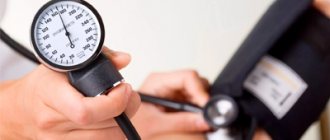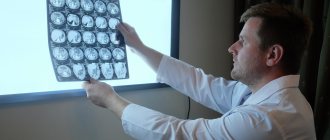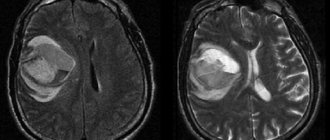Vegetative-vascular dystonia: “mysteries” of diagnosis
Over the years, attitudes towards the diagnosis of VSD have changed both among doctors and patients. Together with a neurologist of the highest category, candidate of medical sciences, head of the consultative and diagnostic department of the clinic of the Federal State Budgetary Institution "Research Institute of Therapy and Preventive Medicine" SB RAS Svetlana Duma, we decided to debunk the myths with which this disease is associated today.
Vegetative-vascular dystonia is indeed a fairly new phenomenon. Knowledge of the autonomic nervous system was first developed only in the twentieth century by academician Alexander Wein. However, today 80% of patients who consult a neurologist have a disorder that doctors characterize as vegetative-vascular dystonia. At the same time, the number of such patients is growing rapidly, and antidepressants, which are used to treat VSD, have long taken first place among the best-selling medications. During the short history of its existence, a clear understanding of this disease has not emerged among patients.
Myth 1.
VSD is a vascular disorder.
In fact
This is an imbalance of all organs and systems for the coordination of which the autonomic nervous system is responsible.
According to the definition of Alexander Wein, VSD is a violation of various functions of the body, usually somatic, that is, physically tangible. The cause of these disorders is a failure in the nervous regulation carried out by the autonomic nervous system. It is she who is responsible for synchronizing the processes occurring in the internal organs.
Myth 2.
The cause of VSD is a chronic disease.In fact
Chronic disease can trigger VSD in older people, but in most cases the cause of VSD is a nervous disorder.
Another exception is adolescents whose hormonal levels change during puberty, as well as people with endocrine pathologies. And yet, according to neurologists, only 20% of patients with vegetative-vascular dystonia have a primary pathology of any organ or system.
“In middle-aged and older people, indeed, VSD can develop against the background of some kind of somatic disease
, says Svetlana Duma.
– This could be pathology of the gastrointestinal tract, vascular diseases of the heart or brain, neurodegenerative diseases, consequences of injuries and infections.
But if we talk about the most common cause of VSD, then these are neurotic disorders - anxiety or anxiety combined with depression.” One of the most complex manifestations of VSD, which has developed on a nervous basis, is panic attacks, that is, sudden inexplicable attacks of fear, accompanied by bodily discomfort. As a rule, these symptoms occur when the patient delays treatment of the pathology without recognizing its psychological, or rather psychiatric, nature.
Myth 3.
There is no diagnosis of VSD.In fact
There is such a diagnosis in disease classifiers, but it is not in its “right” place, hence its “non-existence”: the diagnosis is indeed not somatic, but it is not officially classified as a nervous disease.
Since the true cause of most cases of VSD is a disorder of a nervous nature, in the classification of diseases it, logically, should belong to the section of nervous diseases.
However, due to established practice, the diagnosis of VSD is located among somatic (bodily) diseases. According to doctors, the reason for this discrepancy is that patients with vegetative-vascular dystonia are in no hurry to turn to psychiatric specialists.
“If we exclude an organic cause, we diagnose VSD on the background of an anxiety disorder, although the anxiety disorder comes first here
, says Svetlana Duma.
– If such a patient gets to a psychiatrist or psychotherapist, he will be given, in fact, the correct diagnosis. This will be, for example, a somatoform or anxiety disorder, due to which VSD syndrome develops. This bureaucratic discrepancy is apparently due to the fact that people do not want to go to the right doctor.”
Myth 4.
A doctor may miss a serious disease by diagnosing VSD.In fact
The patient is always carefully examined, even if he is “recognized” as a patient with VSD.
The diagnosis of VSD is made by exclusion. This means that when examining a patient with suspected vegetative-vascular dystonia, all possible somatic pathologies are excluded.
“Experienced neurologists immediately see a patient with VSD, but they cannot take upon themselves the responsibility of diagnosing him without additional examinations,
– explains the doctor.
– We look at the probable objective cause that is causing the problem, and if we do not confirm it, we make a diagnosis of “VSD.”
The patient's examinations include a health check according to a certain standard, which includes an ECG and a blood test. In addition, the patient’s endocrine system is checked - the condition of the thyroid gland, pituitary gland, hypothalamus and adrenal glands.
Myth 5.
VSD is the second name for another disease.In fact
Other names for VSD are related to the fact that at one time they tried to rename this diagnosis, but now it has no official synonyms.
“We have a variant of the diagnosis that, in general, has become obsolete - neurocirculatory dystonia
, says Svetlana Duma.
– It implies slight fluctuations in pressure, minor rhythm disturbances. Now this diagnosis is not made; instead, VSD is given. They tried to rename VSD, for example, there was a syndrome of vegetative dystonia, Alexander Moiseevich Vein proposed “psycho-vegetative syndrome.” The name may vary, but the classification remains “VSD”.
Myth 6.
Symptoms of VSD are concentrated in the head area.In fact
Symptoms can manifest themselves both from the gastrointestinal tract and as pain in the chest.
Neurologists call VSD a multisystem diagnosis: the disorder attacks the patient from an unexpected direction, and sometimes from several sides at once. A patient with VSD may complain, for example, of pain in the heart area, but when questioning the doctor, it turns out that he has been tormented by intestinal problems for a long time, chills appear inappropriately, and sometimes his body temperature fluctuates.
“Very often, patients with VSD complain of pain, from different sides. One of the variants of autonomic dysregulation is functional disorders of the gastrointestinal tract,
— says Svetlana Duma.
– In recent years, they have been encountered so often that gastroenterologists have identified them as a separate category. In the 19th century, these disorders were called intestinal neurosis; now they are functional disorders of the gastrointestinal tract.”
Myth 7.
VSD is a congenital pathology, and at the same time “lifelong”.In fact
VSD is usually acquired in a stressful situation, and it is possible to get rid of dystonia with proper treatment.
According to the doctor, the success of treatment depends on individual “brain chemistry.” As a rule, treatment is quite long, but it does not last for the rest of your life. At the same time, the disease can catch a person, as they say, out of the blue, because almost everyone is exposed to stress today. But it is a stressful situation that often becomes a trigger for symptoms of VSD.
“In the 90s in Novosibirsk there were small echoes of the earthquake, to which many residents reacted with fear and deterioration in health,
- the doctor recalls.
– Then a whole layer of so-called vegetatives went to neurologists.
Sometimes in a stressful situation a person mobilizes and copes with the problem, sometimes very successfully. Often after such situations an anxiety disorder occurs because the body is overstressed and is unable to relax.” How to treat?
Unfortunately, a patient with VSD due to a nervous disorder today is in a difficult situation. On the one hand, he should contact a psychiatrist, but specialists in mental illness, as a rule, do not find sufficient grounds for treatment. The services of their alternative, psychotherapists, are usually not cheap. However, in not very advanced cases, patients with a disorder of the autonomic system can be helped by a neurologist or therapist. According to the doctor, it is they who see the vast majority of such patients.
“In Soviet times, therapists were turned into psychotherapists, but now, of course, there is no such thing,
– says Svetlana Duma.
“ But today a therapist can prescribe first-line antidepressants, which are allowed for everyone.
In this case, it is the nervous disease that needs to be treated – anxiety or anxiety-depressive disorder. We can prescribe mild medications that stabilize autonomic activity, but if the nervous disorder is not treated, after some time all the symptoms will return.”
Prevention of vegetative-vascular dystonia
But prevention of nervous VSD is simple. If it is hardly possible to protect yourself from stress in modern conditions, then everyone can prevent nervous overexertion, the doctor assures. To do this, you just need to set aside some time for rest every day and during the week.
“The body is like a spring; if you constantly strain it, it will react in the form of imbalance,” says Svetlana Duma. – It is also important to learn to enjoy the little things. If a person knows how to have fun every day, that’s great – it improves his health.”
Related articles:
Under the pressure of depression
Panic attacks: silent horror
Physical activity for VSD
Vegetative-vascular dystonia and sports are completely compatible concepts, although it is still not advisable to engage in some sports. Doctors are also wary of recommendations to continue professional sports training with VSD. But moderate physical activity is even welcome, because it increases the effectiveness of therapy. Let's take a closer look at which sports are not dangerous for VSD, and which sports activities should be continued with caution.
- Allowed
With VSD, running, swimming, step aerobics, morning exercises, yoga, and badminton are among the sports that are allowed.
- Forbidden
Martial arts, weightlifting, powerlifting, arm wrestling, kettlebell lifting, bodybuilding, discus throwing are on the black list for the diagnosis of VSD.
Chess is also prohibited for people with VSD. The whole point here is not physical, but emotional stress. In addition, a chess player can sit in one position for hours. A surge of emotions against the background of a lack of muscle load can lead to a hypertensive crisis during VSD.
If you have vascular dystonia and you are going to the gym, here is what you need to remember. The entire lifestyle is of great importance: with VSD, you need a correct daily routine, including at least seven hours of sleep and good nutrition. At the same time, there is no overload on the body. Moreover, it is necessary to forget about overloads during training. When playing sports, it is important not to forget about your pulse and blood pressure. However, do not control them manically, otherwise you will develop neurosis and the effect of the stress will decrease.
Best Sports Workouts
Let's take a closer look at what sports are recommended for VSD.
The best form of physical activity for VSD is running. It uses more than 80% of the muscles, the whole body works. All its systems and internal organs are better supplied with oxygen. If you approach the process correctly, think through a plan for regular training to run, gradually increasing the load, you can easily reduce the symptoms of VSD.
This is because with a gradual increase in loads, the heart muscle will slowly learn to pump a larger volume of blood. The functioning of the brain will also improve, which will begin to receive more oxygen, thought processes will accelerate, and the consequences of neurosis, psychosis and depression will go away. All this will help you more easily survive stress during VSD. With all its advantages, running has one more huge advantage - it is the most accessible sport and in order to practice it, you do not need subscriptions to expensive gyms or expensive equipment. All you need is sneakers and a desire to play sports.
Fitness is an effective way to maintain good physical shape. It represents a set of measures that will help strengthen all muscle groups, the immune and cardiovascular systems, lose weight, and maintain tone. With the help of fitness, you will become more resilient, strong and flexible, rejuvenate your body, and forget about stress and irritability. With the help of fitness, you can also reduce the symptoms of VSD.
Horseback riding, cycling and skiing
Equestrian sports and cycling also have no restrictions in the presence of VSD. But we must remember about the smoothness of movements. In winter, swap your horse or bicycle for skis or skates.
The autonomic system is part of the central nervous system and is responsible for the functionality of all internal organs and their interaction within the system. She is responsible for the following functions:
- ensuring the interaction of reflexes and brain signals;
- perception of the environment, relaxation or tension depending on the factors affecting the psyche;
- the first solution is to activate the parasympathetic department of the autonomic nervous system: nutrition, rest, sleep;
- the second is the sympathetic department: defense and attack of the body.
The ANS consists of two departments, each of which is responsible for its own functions. One allows the body to relax, the other allows the body to tense up.
VSD and charging
To prepare the body of a patient with dystonia for regular heavy exercise, it is necessary to simply do exercises at home for the first month. Just 15–20 minutes daily will give positive results within a month. For hypothalamic dysfunction, it is recommended to perform the following set of exercises:
- Side bends from a standing position. Help strengthen the oblique abdominal muscles and increase blood flow.
- Abdominal exercises from a lying position. Strengthens the spine and abdominal muscles.
- Stand in side and horizontal plank for 1 minute.
- Exercise "bicycle". Increases vascular tone in the legs and improves venous blood flow from the lower extremities to the heart.
- Stretching exercises.
- Lifting dumbbells with your hands.
- Pushups.
A competent approach to organizing physical activity for patients with dystonia is a direct path to improving overall well-being. Along with physical hardening comes optimism and self-confidence.
Sports against the backdrop of VSD
VSD refers to pathological signs associated with impaired functioning of autonomic reactions. Their list can be very extensive. We list the most common ones found in the clinic:
- headache;
- fluctuations in blood pressure and temperature;
- emotional lability;
- excessive sweating (hyperhidrosis);
- periodic and reversible sensitivity disorders (paresthesia);
- chilliness, or periodic feeling of heat;
- redness or paleness of the skin;
- panic attacks, or “vegetative storms”, which are accompanied by the fear of death.
Sport with such symptoms is a controversial issue.
Some doctors try to convince patients that physical activity is undesirable for them and can aggravate the condition.
But there are exercises to normalize the functioning of blood vessels. Therefore, VSD and sport are often interconnected. And in the end, life is movement. And for functional disorders, it is quite possible to choose the right exercises that will not cause unpleasant symptoms.
Recommended types of exercise
When making a diagnosis related to dysfunction of the autonomic system, you need to start every day with physical activity. Immediately after waking up, you need to perform several correctly selected exercises aimed at:
- to strengthen the heart and blood vessels;
- to work with breathing;
- to develop coordination;
- to improve muscle stretching.
Each exercise must be performed slowly, without unnecessary effort, trying to feel muscle pleasure. For concomitant diseases, a set of exercises is selected taking into account not to cause harm. If you have symptoms of cardiovascular diseases such as high or low blood pressure, you must exclude:
- sudden movements;
- increased cardio loads that make you short of breath;
- jumping and shaking, etc.
General recommendations
If the vegetative-vascular system is disordered, you can choose different sports, with the exception of those that cause a heartbeat above normal, shocks and concussions. This could be: Nordic walking, swimming, gentle jogging, cross-country skiing. Training should be regular and moderate. But with VSD, physical therapy (physical therapy) must be included in the adaptation course. The advantages of this type of physical activity are that they:
- performed from a standing or lying position;
- aimed at all muscle groups;
- train breathing and develop coordination and flexibility.
Physical therapy for VSD should be performed regularly. It is better to exercise in the morning, an hour after a light breakfast, an hour before a second breakfast or snack. Exercises should be selected in such a way that strength loads, stretching and relaxation movements alternate. They should be performed slowly, until you feel slightly tired, excluding overwork.
For those who have a diagnosis of VSD, moderate and quiet exercise in the gym is useful, but only in cases where there is a tendency to hypotension: if you have high blood pressure, you cannot exercise on exercise machines.
When putting together a complex using simulators, you must definitely select exercises to improve or correct your posture. Most often, VSD develops in people with poorly developed back muscles. The condition of the spine causes incorrect position of the internal organs, their normal blood supply and function deteriorate. All this aggravates the condition of the patient, who definitely needs to strengthen his back.
Swimming with VSD
Swimming for vegetative-vascular disorders is necessary. This is one of the most gentle and at the same time effective sports. The main goal of water exercises is to develop general endurance and at the same time normalize the functioning of the central nervous system. Calm swimming, without racing for distance and speed, will bring benefits.
Compliance with the contraindications noted by experts for people with VSD can significantly improve the quality of life of the latter and save them from exacerbations of the negative symptoms of this disease.
VSD in children, and what to do about it?
Classification depending on diagnosis
VD is caused by various diseases of the central nervous system, then patients will be observed by specialists in this field. But pediatricians often have to deal with this problem. Usually these are children who have post-traumatic perinatal pathology. Such children are usually registered with a neurologist from birth. Most often, after a year, the bright symptoms of the central nervous system disease disappear. But deviations in autonomic regulation remain. Then neurologists make a diagnosis of VD, and it is already considered independent. There is a classification of vegetative dystonia:
- Somatoform dysfunction of the autonomic nervous system;
- Autonomic nervous system disorders;
- Disorders of the autonomic nervous system, unspecified;
- Hypotension.
But it is worth noting that the diagnosis of vegetative dystonia will be independent only if other types of diseases where VD is a symptom are excluded.
In hospitals, children often experience problems with the cardiovascular system. Pediatric cardiologists call this vegetative-vascular dystonia. Cardiologists use the word neurocirculatory dystonia. From a medical point of view, both phrases are synonymous.
Causes of VSD
Vegetative-vascular dystonia is a complex of symptoms with various manifestations that affect different organs and systems in the human body. The reasons for this violation:
- Stressful state: school, family, work;
- Fast paced society;
- Constantly learning something new;
- Constant loads;
- Information overload;
- Genetic predisposition;
- Little activity;
- Hormonal disbalance.
Main signs of a violation:
- The appearance of the skin changes, its color changes, new patterns of blood vessels appear;
- Failure of the sebaceous and sweat glands;
- Increase or decrease in the child’s weight due to deviation of the endocrine glands;
- Various rashes, frequent itching and swelling;
- Lots of blackheads;
- Fast or slow puberty;
- Frequent changes in body temperature without obvious reasons;
- Change in behavior - a drowsy mood can suddenly give way to attacks of panic and some kind of anxiety;
- Deterioration of breathing and the presence of “shortness of breath” are not the most striking symptom of VSD
, but they do occur; - Disorders of the gastrointestinal tract;
- Nausea, vomiting, diarrhea, constipation, abdominal pain, feeling of a lump in the throat.
The presence of these symptoms does not mean that the child has VSD. This is simply a reason to conduct a full examination and find an obvious cause.
Diagnosis of the disorder
To make a diagnosis, a comprehensive examination is necessary. And children whose VSD has been confirmed should be examined twice a year. During examinations, the doctor observes the history indicators: genealogical, obstetric, and asks questions about the diseases that the child has suffered from. Thus, risk factors that could cause the development of the deviation are identified. It is also necessary to assess psychological, physical condition and puberty.
Then the purity of heart rhythms and blood pressure are measured. The child undergoes various functional tests: breathing exercises, light physical activity. It is also necessary to conduct an ECG, cardiointervalography, and echocardiography. It is these examinations that characterize cardiovascular disease and autonomic homeostasis.
If the data obtained is not enough, then additional examinations are carried out: radiography of the skull, ultrasound of the abdominal cavity, kidneys, adrenal glands, electroencephalography. If necessary, you need to visit doctors: neurologist, cardiologist, gastroenterologist, endocrinologist.
Preventive measures
In order to protect your child from vegetative-vascular dystonia, you need to monitor his health and help maintain a healthy lifestyle. You need to follow a regimen: sleep eight hours a day; frequent spending time in the fresh air; reducing time spent on gadgets. There must be physical development, attendance at various clubs: tennis, outdoor games, skiing, roller skating.
Nutrition also plays an important role. It must be balanced. There is no need to introduce large amounts of salt, fatty meat, sugar, and baked goods into children's diets. On the contrary, the menu should include cereals of any kind, legumes, herbs, dried apricots, nuts, and raisins.
Today it is important to help the child relax on a psychological level, calm the nervous system, and relieve nervous tension. Take her for therapeutic massage and electrophoresis. You also need to take vitamins regularly.
Treatment of VSD in children
To improve the child’s condition, you need to use an integrated approach. It is important that with such a disease, first of all, it is not drugs and medications that help, but the restoration of a normal lifestyle. You need to make a plan where there will be enough physical and mental stress, there will be time for rest and eight hours of sleep. Hardening procedures have a good effect on health.
Therefore, it is worth noting that for vegetative-vascular dystonia, you must first try traditional methods of treatment. Water procedures have a particularly positive effect: swimming, contrast showers, medicinal baths.
If this does not help, then you can supplement it with physiotherapeutic procedures: galvanization, electrophoresis, electrosleep.
But, of course, like any disease, VSD can be treated with medication. But it is important that the doctor makes the appointment after examining, conducting an examination, and receiving test results. Medicines are prescribed by a neurologist. Author: K.M.N., Academician of the Russian Academy of Medical Sciences M.A. Bobyr











